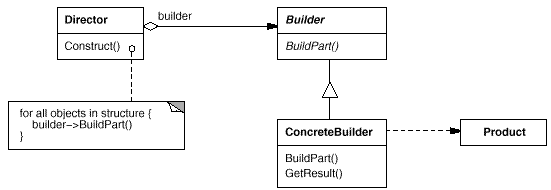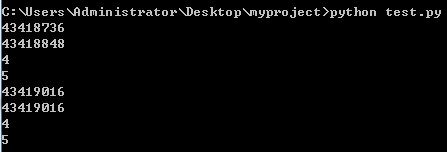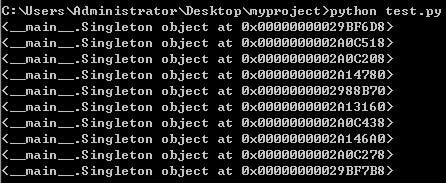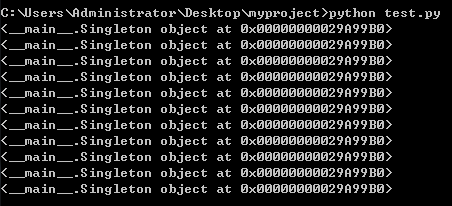单例模式(Singleton Pattern)是 Java 中最简单的设计模式之一。这种类型的设计模式属于创建型模式,它提供了一种创建对象的最佳方式。
这种模式涉及到一个单一的类,该类负责创建自己的对象,同时确保只有单个对象被创建。这个类提供了一种访问其唯一的对象的方式,可以直接访问,不需要实例化该类的对象。
注意:
- 1、单例类只能有一个实例。
- 2、单例类必须自己创建自己的唯一实例。
- 3、单例类必须给所有其他对象提供这一实例。

意图:保证一个类仅有一个实例,并提供一个访问它的全局访问点。
主要解决:一个全局使用的类频繁地创建与销毁。
何时使用:当您想控制实例数目,节省系统资源的时候。
如何解决:判断系统是否已经有这个单例,如果有则返回,如果没有则创建。
关键代码:构造函数是私有的。
应用实例:
- 1、一个班级只有一个班主任。
- 2、Windows 是多进程多线程的,在操作一个文件的时候,就不可避免地出现多个进程或线程同时操作一个文件的现象,所以所有文件的处理必须通过唯一的实例来进行。
- 3、一些设备管理器常常设计为单例模式,比如一个电脑有两台打印机,在输出的时候就要处理不能两台打印机打印同一个文件。
优点:
- 1、在内存里只有一个实例,减少了内存的开销,尤其是频繁的创建和销毁实例(比如管理学院首页页面缓存)。
- 2、避免对资源的多重占用(比如写文件操作)。
缺点:没有接口,不能继承,与单一职责原则冲突,一个类应该只关心内部逻辑,而不关心外面怎么样来实例化。
使用场景:
- 1、要求生产唯一序列号。
- 2、WEB 中的计数器,不用每次刷新都在数据库里加一次,用单例先缓存起来。
- 3、创建的一个对象需要消耗的资源过多,比如 I/O 与数据库的连接等。
注意事项:getInstance() 方法中需要使用同步锁 synchronized (Singleton.class) 防止多线程同时进入造成 instance 被多次实例化。
实现
1、第一种方式
自己定义一个包,例如mySingleton.py
class Singleton(object): def foo(self): pass singleton = Singleton()
然后在其它的python文件中就可以使用:from mySingleton import singleton
2、第二种方式:使用装饰器
def Singleton(cls): _instance={} def _singleton(*args,**kargs): if cls not in _instance: _instance[cls]=cls(*args,**kargs) return _instance[cls] return _singleton @Singleton class A(object): a = 1 def __init__(self, x=0): self.x = x
a1 = A(2)
a2 = A(3)
print(a1.a)
print(a2.a)
print(a1.x)
print(a2.x)
print(id(a1))
print(id(a2))
运行结果:

值得关注的几个点:
(1) a1和a2的内存地址是一致的,说明是同一个对象;
(2)单例模式只实例化一次类,因此a1.x和a2.x的值都是a1初始化之后的值,也就是2。
3、使用类
class Singleton(object): def __init__(self,x): self.x=x @classmethod def instance(cls, *args, **kwargs): if not hasattr(Singleton, "_instance"): Singleton._instance = Singleton(*args, **kwargs) return Singleton._instance a1 = Singleton(4) a2 = Singleton(5) print(id(a1)) print(id(a2)) print(a1.x) print(a2.x) print(id(a1.instance(2))) print(id(a2.instance(3))) print(a1.x) print(a2.x)
输出:

需要关注的几个点:
(1)Singleton的实例a1和a2不是同一个对象,但是a1.instance()和a2.instance()确是同一个对象。
(2)x初始化之后的值没有被instance(x)所改变。
也就是这里的单例实际上是Singleton.instance()
但是上述这种实现会存在线程不安全,例如以下代码:
class Singleton(object): def __init__(self): pass @classmethod def instance(cls, *args, **kwargs): if not hasattr(Singleton, "_instance"): Singleton._instance = Singleton(*args, **kwargs) return Singleton._instance import threading def task(arg): obj = Singleton.instance() print(obj) for i in range(10): t = threading.Thread(target=task,args=[i,]) t.start()

看起来也没有问题,那是因为执行速度过快,如果在init方法中有一些IO操作,就会发现问题了,下面我们通过time.sleep模拟
我们在上面__init__方法中加入以下代码:
def __init__(self): import time time.sleep(1)

问题出现了!按照以上方式创建的单例,无法支持多线程
解决办法:加锁!未加锁部分并发执行,加锁部分串行执行,速度降低,但是保证了数据安全
import time import threading class Singleton(object): _instance_lock = threading.Lock() def __init__(self): time.sleep(1) @classmethod def instance(cls, *args, **kwargs): with Singleton._instance_lock: if not hasattr(Singleton, "_instance"): Singleton._instance = Singleton(*args, **kwargs) return Singleton._instance def task(arg): obj = Singleton.instance() print(obj) for i in range(10): t = threading.Thread(target=task,args=[i,]) t.start() time.sleep(20) obj = Singleton.instance() print(obj)

这样就差不多了,但是还是有一点小问题,就是当程序执行时,执行了time.sleep(20)后,下面实例化对象时,此时已经是单例模式了,但我们还是加了锁,这样不太好,再进行一些优化,把intance方法,改成下面的这样就行:
@classmethod def instance(cls, *args, **kwargs): if not hasattr(Singleton, "_instance"): with Singleton._instance_lock: if not hasattr(Singleton, "_instance"): Singleton._instance = Singleton(*args, **kwargs) return Singleton._instance
这样,一个可以支持多线程的单例模式就完成了。
4、基于__new__方法实现(推荐使用,方便)
通过上面例子,我们可以知道,当我们实现单例时,为了保证线程安全需要在内部加入锁
我们知道,当我们实例化一个对象时,是先执行了类的__new__方法(我们没写时,默认调用object.__new__),实例化对象;然后再执行类的__init__方法,对这个对象进行初始化,所有我们可以基于这个,实现单例模式
import threading class Singleton(object): _instance_lock = threading.Lock() def __init__(self): pass def __new__(cls, *args, **kwargs): if not hasattr(Singleton, "_instance"): with Singleton._instance_lock: if not hasattr(Singleton, "_instance"): Singleton._instance = object.__new__(cls) return Singleton._instance obj1 = Singleton() obj2 = Singleton() print(obj1,obj2) def task(arg): obj = Singleton() print(obj) for i in range(10): t = threading.Thread(target=task,args=[i,]) t.start()
采用这种方式的单例模式,以后实例化对象时,和平时实例化对象的方法一样 obj = Singleton()
5、基于metaclass实现
""" 1.类由type创建,创建类时,type的__init__方法自动执行,类() 执行type的 __call__方法(类的__new__方法,类的__init__方法) 2.对象由类创建,创建对象时,类的__init__方法自动执行,对象()执行类的 __call__ 方法 """
class Foo: def __init__(self): pass def __call__(self, *args, **kwargs): pass obj = Foo() # 执行type的 __call__ 方法,调用 Foo类(是type的对象)的 __new__方法,用于创建对象,然后调用 Foo类(是type的对象)的 __init__方法,用于对对象初始化。 obj() # 执行Foo的 __call__ 方法
元类的使用:
class SingletonType(type): def __init__(self,*args,**kwargs): super(SingletonType,self).__init__(*args,**kwargs) def __call__(cls, *args, **kwargs): # 这里的cls,即Foo类 print('cls',cls) obj = cls.__new__(cls,*args, **kwargs) cls.__init__(obj,*args, **kwargs) # Foo.__init__(obj) return obj class Foo(metaclass=SingletonType): # 指定创建Foo的type为SingletonType def __init__(self,name): self.name = name def __new__(cls, *args, **kwargs): return object.__new__(cls) obj = Foo('xx')
实现单例模式:
import threading class SingletonType(type): _instance_lock = threading.Lock() def __call__(cls, *args, **kwargs): if not hasattr(cls, "_instance"): with SingletonType._instance_lock: if not hasattr(cls, "_instance"): cls._instance = super(SingletonType,cls).__call__(*args, **kwargs) return cls._instance class Foo(metaclass=SingletonType): def __init__(self,name): self.name = name obj1 = Foo('name') obj2 = Foo('name') print(obj1,obj2)
结果:

参考:
https://www.runoob.com/design-pattern/singleton-pattern.html
https://www.cnblogs.com/chillax1314/articles/8287333.html
https://my.oschina.net/u/4051725/blog/4379773
https://www.cnblogs.com/ExMan/p/10426937.html